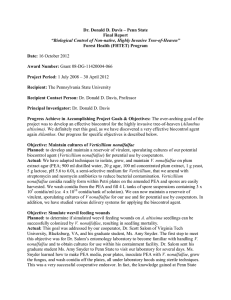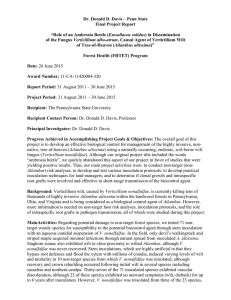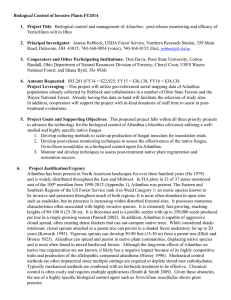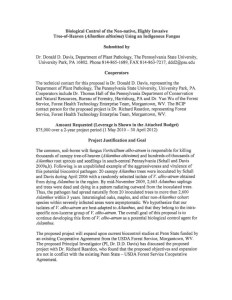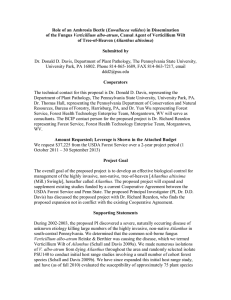10/12/2010 TITLE: Forest Restoration in Appalachia Ohio.
advertisement
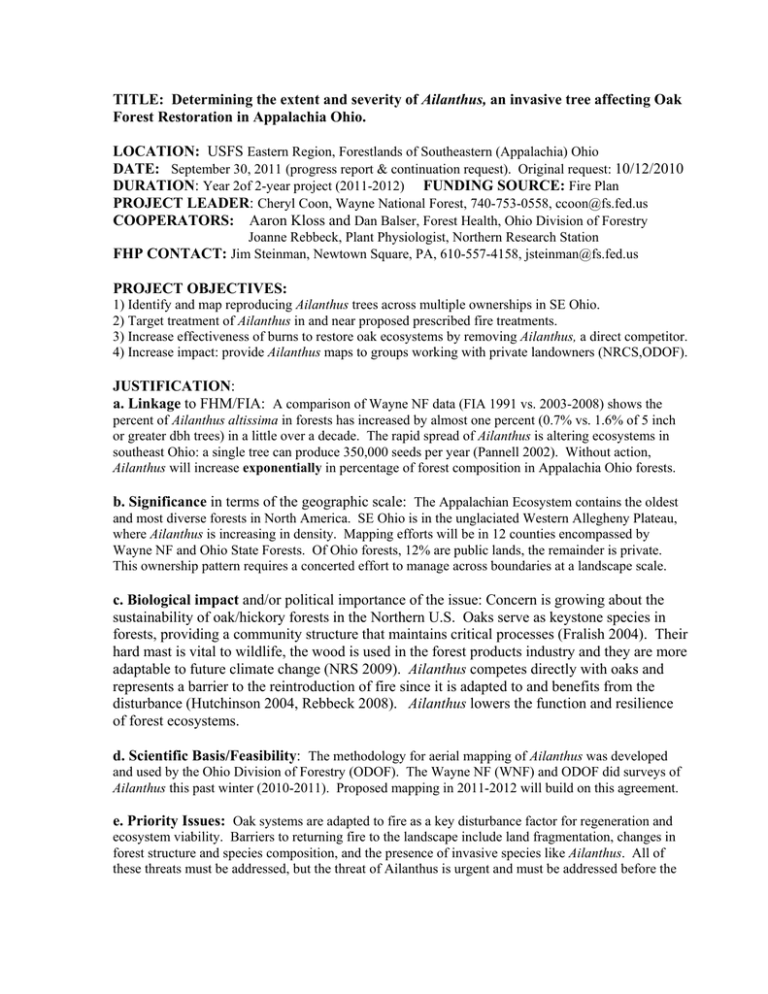
TITLE: Determining the extent and severity of Ailanthus, an invasive tree affecting Oak Forest Restoration in Appalachia Ohio. LOCATION: USFS Eastern Region, Forestlands of Southeastern (Appalachia) Ohio DATE: September 30, 2011 (progress report & continuation request). Original request: 10/12/2010 DURATION: Year 2of 2-year project (2011-2012) FUNDING SOURCE: Fire Plan PROJECT LEADER: Cheryl Coon, Wayne National Forest, 740-753-0558, ccoon@fs.fed.us COOPERATORS: Aaron Kloss and Dan Balser, Forest Health, Ohio Division of Forestry Joanne Rebbeck, Plant Physiologist, Northern Research Station FHP CONTACT: Jim Steinman, Newtown Square, PA, 610-557-4158, jsteinman@fs.fed.us PROJECT OBJECTIVES: 1) Identify and map reproducing Ailanthus trees across multiple ownerships in SE Ohio. 2) Target treatment of Ailanthus in and near proposed prescribed fire treatments. 3) Increase effectiveness of burns to restore oak ecosystems by removing Ailanthus, a direct competitor. 4) Increase impact: provide Ailanthus maps to groups working with private landowners (NRCS,ODOF). JUSTIFICATION: a. Linkage to FHM/FIA: A comparison of Wayne NF data (FIA 1991 vs. 2003-2008) shows the percent of Ailanthus altissima in forests has increased by almost one percent (0.7% vs. 1.6% of 5 inch or greater dbh trees) in a little over a decade. The rapid spread of Ailanthus is altering ecosystems in southeast Ohio: a single tree can produce 350,000 seeds per year (Pannell 2002). Without action, Ailanthus will increase exponentially in percentage of forest composition in Appalachia Ohio forests. b. Significance in terms of the geographic scale: The Appalachian Ecosystem contains the oldest and most diverse forests in North America. SE Ohio is in the unglaciated Western Allegheny Plateau, where Ailanthus is increasing in density. Mapping efforts will be in 12 counties encompassed by Wayne NF and Ohio State Forests. Of Ohio forests, 12% are public lands, the remainder is private. This ownership pattern requires a concerted effort to manage across boundaries at a landscape scale. c. Biological impact and/or political importance of the issue: Concern is growing about the sustainability of oak/hickory forests in the Northern U.S. Oaks serve as keystone species in forests, providing a community structure that maintains critical processes (Fralish 2004). Their hard mast is vital to wildlife, the wood is used in the forest products industry and they are more adaptable to future climate change (NRS 2009). Ailanthus competes directly with oaks and represents a barrier to the reintroduction of fire since it is adapted to and benefits from the disturbance (Hutchinson 2004, Rebbeck 2008). Ailanthus lowers the function and resilience of forest ecosystems. d. Scientific Basis/Feasibility: The methodology for aerial mapping of Ailanthus was developed and used by the Ohio Division of Forestry (ODOF). The Wayne NF (WNF) and ODOF did surveys of Ailanthus this past winter (2010-2011). Proposed mapping in 2011-2012 will build on this agreement. e. Priority Issues: Oak systems are adapted to fire as a key disturbance factor for regeneration and ecosystem viability. Barriers to returning fire to the landscape include land fragmentation, changes in forest structure and species composition, and the presence of invasive species like Ailanthus. All of these threats must be addressed, but the threat of Ailanthus is urgent and must be addressed before the window of opportunity is lost. Eradication of Ailanthus will improve opportunities for using prescribed fire as a restoration tool and increase the function and resiliency of oak forests to future climate change. DESCRIPTION: a. Background: Ohio’s forests are at a crossroads. Historical fire regimes have been interrupted. The dominant oak systems are declining and gradually being replaced by shade-tolerant and firesensitive trees. Forest health is being impacted by non-native invasive plant and insect species. Without an ecosystem approach to restoration, forest composition will continue to shift away from oak, invasive species will occupy more of the landscape, biological diversity will continue to be lost and forests will lose their resiliency and ability to respond to climate change. Ailanthus can invade and expand dramatically in disturbed forests. It invades via abundant wind-dispersed seed and can persist and expand by clonal growth. Oak forests of the Appalachians require fire disturbance to restore and maintain their function, however Ailanthus is present in many oak landscapes. The WNF Forest Management Plan identifies sustaining oak forests a primary objective. In partnership with Ohio Division of Forestry (ODOF), WNF is working to eradicate Ailanthus from Appalachia Ohio. The Ailanthus objectives are to: 1) aerially map reproducing populations (female trees) and 2) use these maps to prioritize invasive control treatments in conjunction with restoration treatments. The desired outcome is to eliminate reproducing Ailanthus stands and other underlying invasive species on public lands. Invasive treatments will be coordinated “across the fence” with willing private landowners implementing Forest Stewardship Plans in association with NRCS. b. Methods: Aerial mapping is done by ODOF through a multi-year Challenge Cost Share agreement. The mapping is done using digital aerial sketch mapping (DASM) from a helicopter, a proven technique that ODOF used for large-scale surveys of forest health. Aerial mapping occurs in fall and winter months, after leaf drop, when aerial observers can identify the seed-producing Ailanthus females. Prominent Ailanthus seed clusters persist through winter and are easily identifiable from the air. c. Products: • • • Reproducing stands of Ailanthus mapped across 240,000+ acres of Appalachia Ohio. GIS maps of Ailanthus created for all ownerships to prioritize Ailanthus treatments. Maps of Ailanthus shared with NRCS and ODOF to help identify private land owners in need of assistance writing Forest Stewardship plans to secure public funds. d. Schedule of Activities, Year 2 of 2 (2011-2012): • Oct. 2011– Feb. 2012: Aerially map 80,000+ acres on Athens and Ironton Ranger Districts for future planned landscape silviculture/fire projects (Baileys and Pine Creek). NEPA: 2012-13. e. Progress/Accomplishments, Year 1 of 2 (2010-2011): • • Oct. 2010-Feb. 2011: Aerially surveyed 163,256 acres: mapped 1,376 areas of Ailanthus infesting 6,408 acres on public and private lands. The areas include future landscape silviculture/fire projects (Pleasant Bear and Buckeye) on the WNF. Used FHM EM grant funds to leverage a $10,000 grant from North Central IPM to ground truth aerial mapping, survey for potential biocontrol (Verticillium albo-atrum), control Ailanthus and conduct 3workshops to train federal personnel and the public about Ailanthus and V. albo-atrum. Treated 1,175 acres of Ailanthus in Pleasant Bear & Buckeye projects as ongoing prevention. Shared maps of entire mapped areas at 2 public workshops and with NRCS personnel. • • Figure 1. Aerially mapped Ailanthus, on federal & public lands, in future USFS vegetation project (Pleasant Bear), Washington County, OH. Previously identified invasive treatments (green) are being reassessed to prevent Ailanthus spread in future fire and silvicultural treatments (hatched). COSTS: Year 2011 Item Administration Salary ODOF Staff (surveys) $30/hr for 3 weeks Salary WNF staff – coordination and oversight $330/day x 10 days Procurements Helicopter time for 3 weeks of aerial surveys (map 80,000 acres) Total Year 2012 Item Administration Salary ODOF Staff (surveys) $30/hr for 3 weeks Salary WNF staff – coordination and oversight $330/day x 10 days Procurements Helicopter time for 3 weeks of aerial surveys (map 80,000 acres) Total FHM EM $ 35,000 35,000 Requested FHM EM $ 35,000 35,000 Other Funds Source 5,040 3,300 ODOF WNF 35,000 43,340 ODOF Other Funds Source 5,040 3,300 ODOF WNF 35,000 43,340 ODOF Literature Cited Fralish, J.S. 2004. The keysone role of oak and hickory in the central hardwood forest. In; Spetich, Martin A., ed. Upland oak ecology symposium: history, current conditions, and sustainability. Gen. Tech. Rep. SRS-73. USDA, USFS, Southern Research Station: 78-87. Hutchinson, T., J. Rebbeck, R. Long. 2004. Abundant establishment of Ailanthus altissima after restoration treatments in an upland oak forest. Proceedings of the 14th Central Hardwood Forest Conference. GTR-NE-316. p. 514. Rebbeck J., T.Hutchinson, D.Yaussy, I.Iverson, 2008. Prescribing fire in managed oak forest landscapes: interactions with the invasive tree Ailanthus altissima. Joint Fire Science Program Project number: 08-1-2-07. http://nrs.fs.fed.us/units/sustainingforests/local-resources/docs/REBBECK_JFSP_study%20plan.pdf NRS (Northern Research Station) 2009. Ohio Forests 2006. Resource Bulletin NRS-36. USDA, Forest Service, Northern Research Station: 62. Pannell, P.D. 2002. Tree-of-heaven control. Maryland Department of Natural Resources Forest Service Stewardship Bulletin, Hagerstown, MD.
